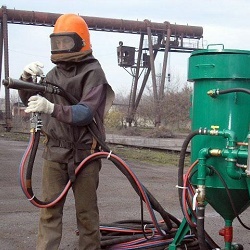Choosing a hose on the compressor
The further safe operation of the compressor as a whole depends on the correct choice of the “sleeve”. "Sleeve", as a rule, is called the usual hose for the compressor. Despite the seeming simplicity, this product hides several features. With the choice of hose for the compressor faces every owner of this unit.
Content
Purpose of the compressor hose
The sleeve for the compressor is required to supply air from the compressor to the connected pneumatic tool:
- wrench;
- spray gun;
- airbrush;
- pistol;
- grinder;
- drill;
- zaklepochnik and others.
As a rule, the compressor equipment is not completed with a rubber hose, and it needs to be bought in addition separately.
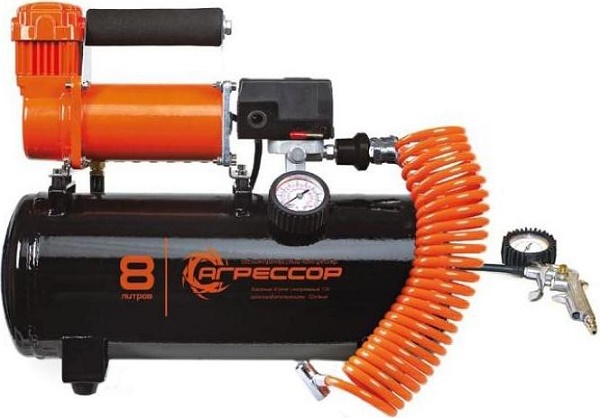
Types of sleeves
Of course, like any other object, the hose to the compressor is classified according to the areas of application and technical parameters. The most common division is straight and twisted product.
Direct for the organization of the pneumatic line
As a rule, such a hose has largest diameter and throughput. It is usually used where large discharge pressure is required. Straight trunk hose is well reinforced (reinforced) and has the greatest resistance to temperature changes. Most often, this sleeve format is used in industry and manufacturing.
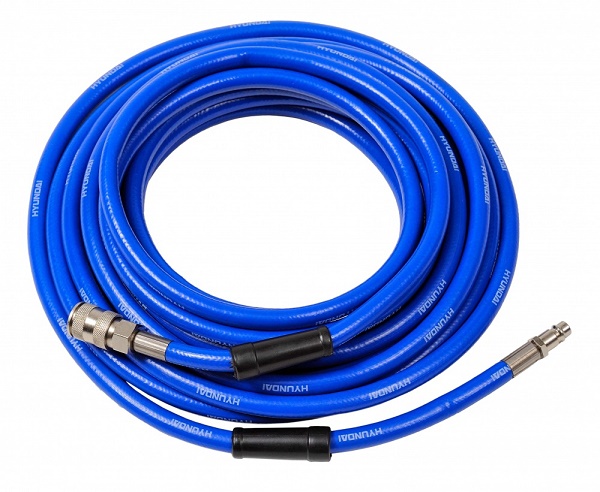
Twisted (Spiral)
The most common type of sleeve received in all kinds of car serviceswhere pneumatic tools are most often used (wheel pumping, drills, etc.). The peculiarity of the twisted hose is that it is manufactured using a technology that does not allow it to straighten. Even in a free position, he will tend to a twisted spiral position. This fact makes it compact and easy to store. In addition, the worker does not need to take care of the installation of the equipment: immediately after the completion of operation, such a hose is simply twisted into a spiral.
Important! The diameter and throughput of a twisted sleeve can vary depending on the area of its application, but more often they are much smaller than the main one.

Selection characteristics
Any technical product implies certain parameters by which it is selected. In the case of a compressor hose, the parameters are determined by the length, diameter, material of manufacture, type of connection and pressure that the product is able to withstand.
Length
One of the important parameters when choosing a product. If the length of the air hose is not correct, then pressure loss will be proportional. In some cases, the pressure may subside is not so significant as to attract attention, in others the drawdown will be visible to the naked eye. In any case, the parameters for choosing the length of the hose should be taken seriously.
This parameter directly depends on the power of the compressor itself: the higher the power, the longer the sleeve can be. It is best to choose the length depending on the model of a particular compressor - this is more likely the optimal ratios of all characteristics.In the future, when replacing the hose, it is best to simply buy a segment of the same length.
It should be noted that the length of the hose should be taken care of in advance. If a working length (the length at which the compressor is capable of delivering the working pressure) will turn out to be insufficient, it will be necessary to solve many tasks for optimizing the workflow. Traditional sizes of hoses are 6, 8, 12, as well as 15 meters.
Important! During operation, it should be remembered that it is not recommended to tighten the hose.
Diameter
The hose is important to choose the right diameter. From this parameter will depend capacity of the product. Accordingly, the larger the diameter, the greater the amount of air the compressor is able to pump in one unit of time. Diameter is extremely important when operating a specialized pneumatic tool, since there is a fairly intense air pumping during short breaks. The larger the diameter of the inner ring of the product, the better it is suitable for operation in conjunction with a compressor for pneumatic equipment and working with high pressure. Hoses with a small diameter have a lower pumpability, therefore, have a lower efficiency.However, in some cases it can be limited to a spiral-shaped sleeve of small diameter, the main thing is that it provides the pressure necessary for proper air supply.
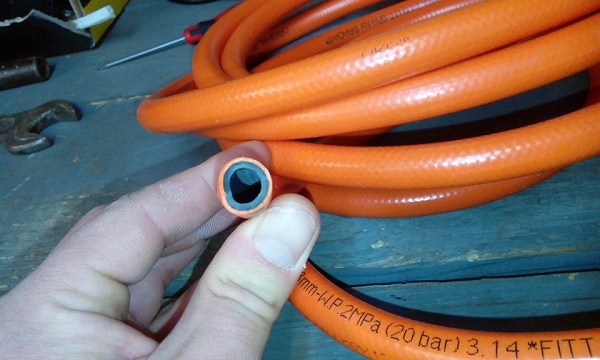
It is also important to pay attention to the following feature: the greater the wall thickness of the hose, the greater the impact it is able to withstand.
Standard diameter of spiral sleeves is 6x8 mm (internal / external), but you can find 8x10 mm. The latter are less common and are used to solve highly specialized tasks. In most cases, it can be limited to using standard sample sizes.
Material
Sleeves are made from several basic materials. Not only the price of the product, but also its performance characteristics will depend on the material of manufacture.
- Plastic. Plastic sleeves are considered the lightest of the presented materials. They do an excellent job with low temperatures and gross physical effects. One of the main recommendations from manufacturers of such hoses is to operate only in a heated room. A great option for use in a building or storage room.
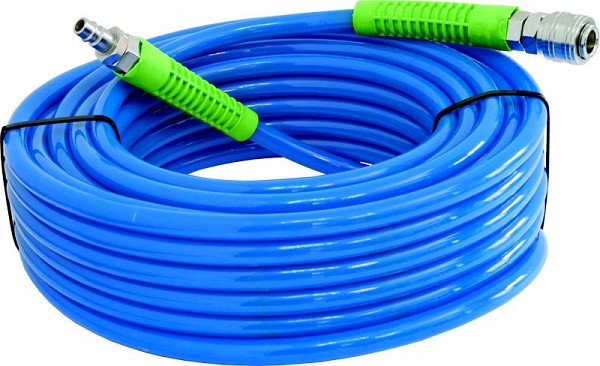
- Rubber. By itself, the rubber retains its performance properties for much longer than any plastic. The main disadvantage of rubber hoses is weight, they are much heavier than their plastic counterparts. Although such hoses are more flexible. However, with prolonged use, the severity of the sleeve can cause increased fatigue.

- Polyurethane. Polyurethane hose is the optimal ratio of all basic operational properties. It is rather easy, strong, remarkably transfers cold temperature and aggressive operation. If you plan to use a spiral hose for air, then in most cases it will be better to give preference to polyurethane.
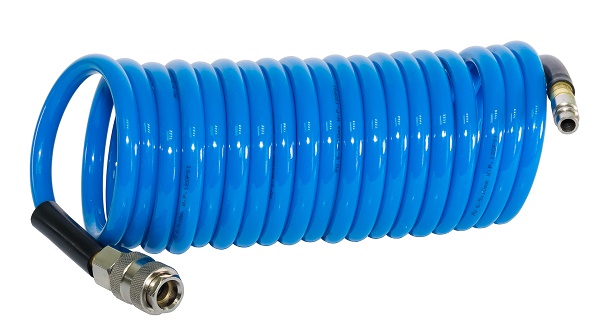
- Armored sleeve. This is a hybrid of rubber and polyurethane. Most often, such a product is reinforced with an additional coating of synthetic yarns, which makes the hose more resistant to falls and compression. Even if you run into such a hose with an inflated wheel, it is unlikely to somehow harm him. Unfortunately, the coating significantly adds weight to the already difficult material. The reinforced sleeves are considered the heaviest.Their use is justified where a strong, wear-resistant material is required. Most often they are used when laying the main pneumatic line. Also used for compressors and high pressure devices.
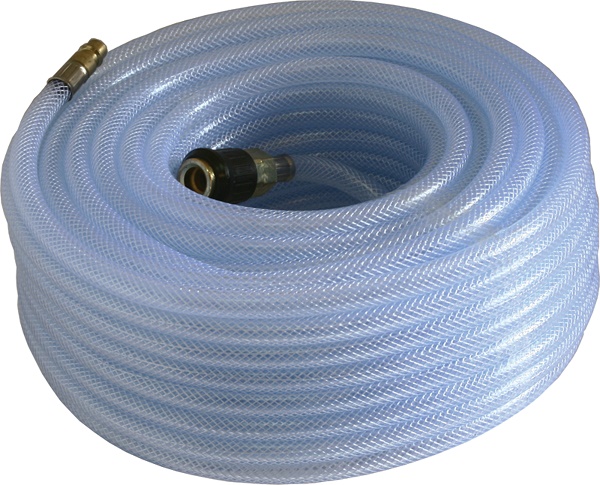
Connection type
The type of connection is directly related to the internal diameter of the sleeve. The most common sizes are 6 mm and 9 mm. It is enough to insert such products into the compressor and to stretch them thoroughly with special clamps. For spiral hoses designed for pneumatic tools, there are screwed connections on screws with a diameter of ¼ and 3/8 inches, respectively. To connect the end of the hose to the device, you must use the appropriate europieces quick coupling. Such a coupling, once inserted, greatly facilitates all subsequent connections to the compressor. This is very convenient when the machine or compressor is one, and several tools are connected to it one at a time.
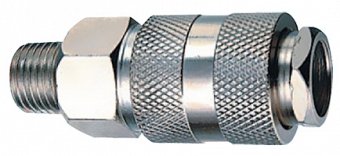
Also, fittings are used to unify and combine hoses of different diameters into one air line. This is a special tool for branching, which is used when laying the highway and its turns.
To quickly switch between tools are used Express replacement compounds, so-called. “Quick coupler”:
- bayonet connection;
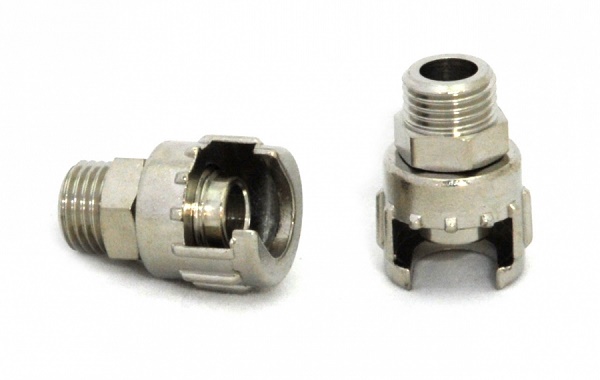
- air shutter connection.

Both types allow you to quickly connect hoses of different diameters using appropriate adapters.
Operating pressure
The last parameter is also the most important. If the pressure in the hose does not meet the requirements, the material of the product will quickly deteriorate.. In the most worn parts of the sleeves, a rupture may occur, which, when working with pressure, leads to undesirable "slamming", not to mention other, even less pleasant consequences.
Some hoses operate at pressures up to ten atmospheres (high pressure hoses), but this is very much. The most common working pressure is 6-8 bar. The regulator of the oxygen autocompressor can be set to a maximum while the product is prepared for working with such parameters. It happens that the pressure must be increased, but the parameter can no longer be added, the handle is in the extreme position. In this case, all the pressure goes into the hose of the installation or compressor.Therefore, when choosing a product is extremely important to focus on this parameter. Without taking into account the load the correct operation of the hose under pressure is impossible.
Without exception, all the sleeves have a certain margin of safety. Most often, this indicator ranges from 2.5 to 1 to 4 to 1. However, it is worth noting that the increased load negatively affects the strength characteristics of any product, especially working under pressure.
The easiest working pressure is set for automobile compressor with pressure gauge, because the latter allows you to take into account the parameters of pressure in real time. If the machine or compressor does not have a pressure gauge, then it is best to examine the pressure parameters before purchasing to secure the work.
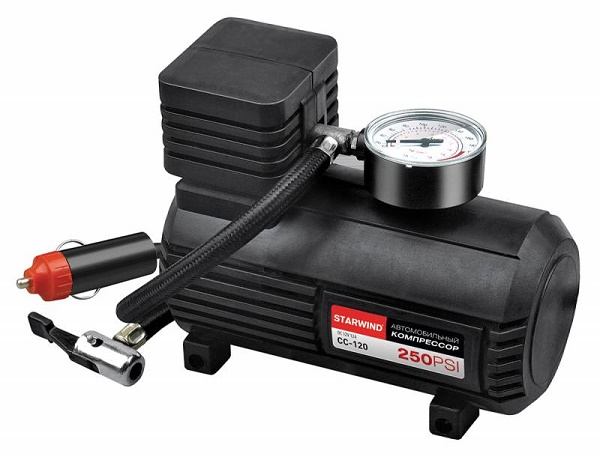
Conclusion
Choosing a hose for a compressor is a task that requires some knowledge. At first glance, it is necessary to consider only a few parameters. On the other hand, it is worth making a mistake in at least one of them, and further exploitation can be problematic. The task requires careful study of all parameters of the product being purchased and familiarity with the main characteristics of the compressor, in conjunction with which it is planned to operate the hose.

/rating_off.png)








